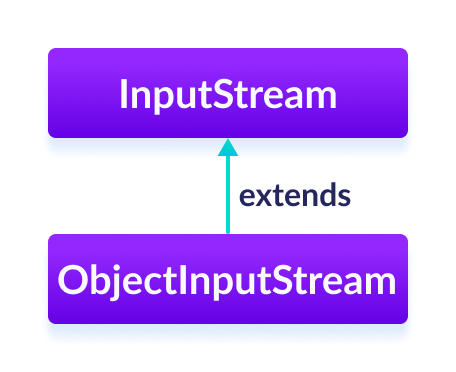The ObjectInputStream class of the java.io package can be used to read objects that were previously written by ObjectOutputStream.
It extends the InputStream abstract class.

Before you learn about the ObjectInputStream class, make sure you know about the ObjectOutputStream Class.
Working of ObjectInputStream
The ObjectInputStream is mainly used to read data written by the ObjectOutputStream.
Basically, the ObjectOutputStream converts Java objects into corresponding streams. This is known as serialization. Those converted streams can be stored in files or transferred through networks.
Now, if we need to read those objects, we will use the ObjectInputStream that will convert the streams back to corresponding objects. This is known as deserialization.
Create an ObjectInputStream
In order to create an object input stream, we must import the java.io.ObjectInputStream package first. Once we import the package, here is how we can create an input stream.
// Creates a file input stream linked with the specified file
FileInputStream fileStream = new FileInputStream(String file);
// Creates an object input stream using the file input stream
ObjectInputStream objStream = new ObjectInputStream(fileStream);
In the above example, we have created an object input stream named objStream that is linked with the file input stream named fileStream.
Now, the objStream can be used to read objects from the file.
Methods of ObjectInputStream
The ObjectInputStream class provides implementations of different methods present in the InputStream class.
read() Method
read()- reads a byte of data from the input streamreadBoolean()- reads data in boolean formreadChar()- reads data in character formreadInt()- reads data in integer formreadObject()- reads the object from the input stream
Example 1: Java ObjectInputStream
Let's see how we can use the ObjectInputStream class to read objects written by the ObjectOutputStream class.
import java.io.FileInputStream;
import java.io.FileOutputStream;
import java.io.ObjectInputStream;
import java.io.ObjectOutputStream;
class Main {
public static void main(String[] args) {
int data1 = 5;
String data2 = "This is programiz";
try {
FileOutputStream file = new FileOutputStream("file.txt");
ObjectOutputStream output = new ObjectOutputStream(file);
// Writing to the file using ObjectOutputStream
output.writeInt(data1);
output.writeObject(data2);
FileInputStream fileStream = new FileInputStream("file.txt");
// Creating an object input stream
ObjectInputStream objStream = new ObjectInputStream(fileStream);
//Using the readInt() method
System.out.println("Integer data :" + objStream.readInt());
// Using the readObject() method
System.out.println("String data: " + objStream.readObject());
output.close();
objStream.close();
}
catch (Exception e) {
e.getStackTrace();
}
}
}
Output
Integer data: 5 String data: This is programiz
In the above example, we have used the readInt() and readObject() method to read integer data and object data from the file.
Here, we have used the ObjectOutputStream to write data to the file. We then read the data from the file using the ObjectInputStream.
Example 2: Java ObjectInputStream
Let's see another practical example,
import java.io.FileInputStream;
import java.io.FileOutputStream;
import java.io.ObjectInputStream;
import java.io.ObjectOutputStream;
import java.io.Serializable;
class Dog implements Serializable {
String name;
String breed;
public Dog(String name, String breed) {
this.name = name;
this.breed = breed;
}
}
class Main {
public static void main(String[] args) {
// Creates an object of Dog class
Dog dog = new Dog("Tyson", "Labrador");
try {
FileOutputStream file = new FileOutputStream("file.txt");
// Creates an ObjectOutputStream
ObjectOutputStream output = new ObjectOutputStream(file);
// Writes objects to the output stream
output.writeObject(dog);
FileInputStream fileStream = new FileInputStream("file.txt");
// Creates an ObjectInputStream
ObjectInputStream input = new ObjectInputStream(fileStream);
// Reads the objects
Dog newDog = (Dog) input.readObject();
System.out.println("Dog Name: " + newDog.name);
System.out.println("Dog Breed: " + newDog.breed);
output.close();
input.close();
}
catch (Exception e) {
e.getStackTrace();
}
}
}
Output
Dog Name: Tyson Dog Breed: Labrador
In the above example, we have created
ObjectOutputStreamnamed output using theFileOutputStreamnamed fileObjectInputStreamnamed input using theFileInputStreamnamed fileStream- An object dog of the Dog class
Here, we have then used the object output stream to write the object to the file. And, the object input stream to read the object from the file.
Note: The Dog class implements the Serializable interface. It is because the ObjectOutputStream only writes the serializable objects to the output stream.
Other Methods Of ObjectInputStream
| Methods | Descriptions |
|---|---|
available() |
returns the available number of bytes in the input stream |
mark() |
marks the position in input stream up to which data has been read |
reset() |
returns the control to the point in the input stream where the mark was set |
skipBytes() |
skips and discards the specified bytes from the input stream |
close() |
closes the object input stream |
To learn more, visit Java ObjectInputStream (official Java documentation).
Also Read: